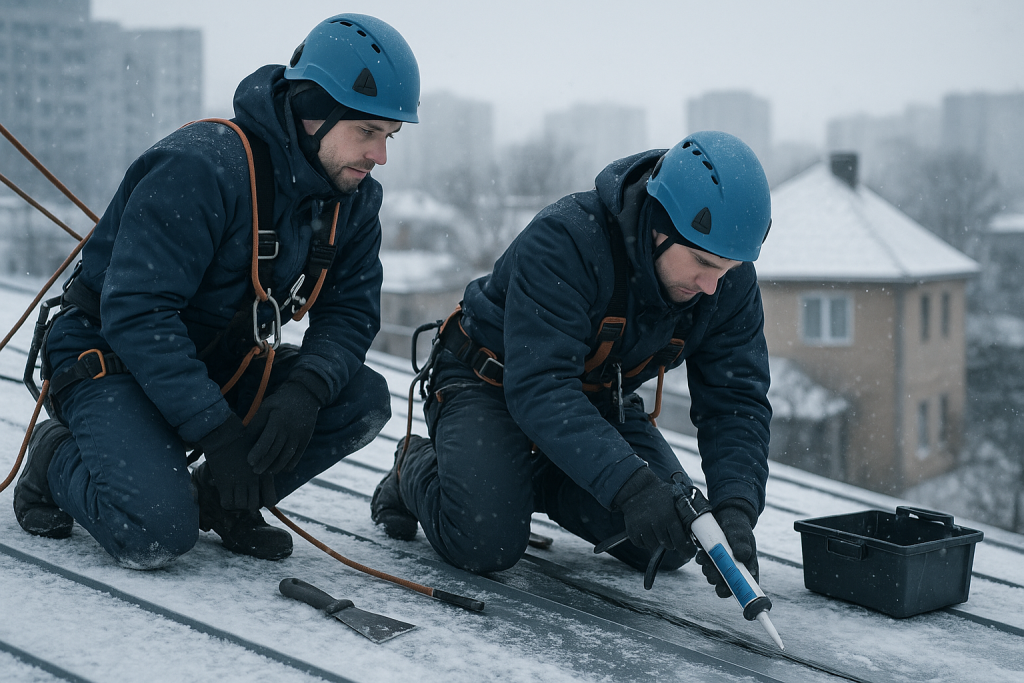How climbers quickly and safely repair roof leaks in winter

Winter increases the load on the roof due to snow, ice, freezing joints, and temperature fluctuations, which accelerates roof leakage even with minor defects. Moisture enters the structure through microcracks, damaged joints, and damaged waterproofing. If roof leaks are not repaired in a timely manner, the situation quickly deteriorates: insulation gets wet, heat loss increases, and internal leaks occur. In winter, access to roofing areas is limited, surfaces are slippery, and the use of equipment is often impossible. In such conditions, an industrial climber becomes a key specialist, capable of quickly repairing roof leaks in the safest possible conditions.
Advantages of industrial climbing in winter
Mountaineers do not need to install heavy structures that can damage the roof covering or create additional load on the icy slope. The experience of high-altitude workers allows them to take into account the behavior of materials in frost conditions and correctly select the method of repairing the roof from leaks. Specialists monitor the condition of joints, assess the area of moisture penetration, and prevent its further spread.
Methods used by mountaineers:
- Clearing the site of ice and snow for full access;
• Sealing joints with frost-resistant compounds;
• Local heating of roof elements to restore watertightness; - Removal of ice and blockages causing roof leaks and gutter overload.
These methods allow emergency leaks to be repaired even at sub-zero temperatures, when standard approaches become ineffective.
When to call in the high-altitude specialists
In winter, it is important to know where to turn in case of a roof leak. Incorrect independent actions can damage the roof covering and increase the defect. At many sites, access is only possible using industrial climbing technology.
Situations when climbers are needed:
- significant height of the object and lack of space for installing equipment;
- damage located in the area of overhangs and cornices;
- defects in joints in areas with complex architectural designs.
Mountaineers repair roof leaks precisely and carefully. They quickly determine the path of moisture penetration, prevent secondary wetting, and stabilize the condition of the structure. This approach helps prevent further damage and reduce the cost of building restoration.
How specialists determine the repair method
Before starting work, diagnostics are carried out: the condition of the waterproofing, joints, seams, and drainage elements is determined. It is important to identify the source, as traces of leakage inside the room do not always coincide with the actual area of the defect. After analysis, a roof repair technology is selected: sealant restoration, membrane gluing, joint reinforcement, drainage system cleaning, or temporary protection of the damaged area. This approach reduces the risk of roof leaks recurring and ensures stable roof performance during the winter.
Vulnerable elements include eaves, areas around ventilation outlets, areas adjacent to vertical walls, utility passages, areas where snow accumulates, and LED loads. These areas require particularly careful treatment.
To minimize risks, it is important to prepare the roof for the winter season in advance: clean gutters, reinforce joints, repair damage, and check the condition of the waterproofing. If necessary, preventive inspections of hard-to-reach areas are carried out with the help of climbers. It is important to limit the formation of large ice formations, clear snow in a timely manner, and check the condition of the joints. Such measures significantly reduce the likelihood of roof repairs due to leaks and help to understand how to protect the roof from leaks in conditions of severe frost and snow loads.
Why industrial climbers are the best choice
Winter leak repair requires a high level of professionalism, safe access, accurate diagnosis, and an understanding of how roofing materials behave at low temperatures. Industrial climbers repair roof leaks even when completely iced over, work safely at any height, and use technologies adapted for winter conditions. Thanks to their expertise, roof leak repairs are carried out quickly, reliably, and without risk of damage to the structure. This makes climbers the best solution for roof maintenance during the difficult winter period, when speed and accuracy are especially important.
Interesting articles:
Advantages of using climbers to install anti-icing systems on complex and hard-to-reach roofs
How climbers lift large-format porcelain stoneware and tiles: features of technology and equipment
